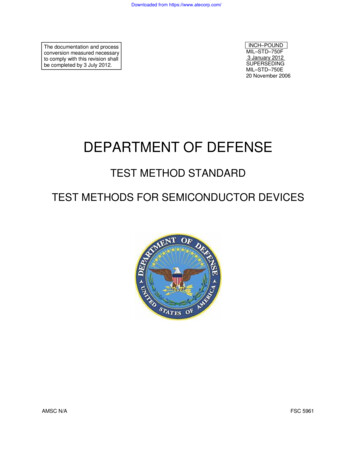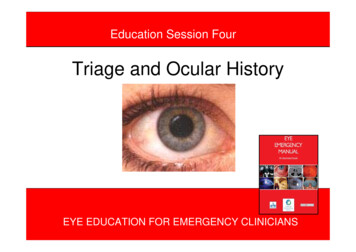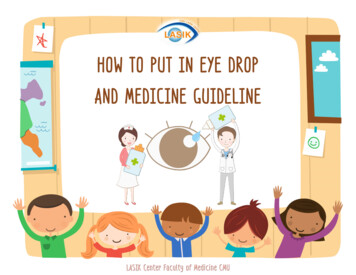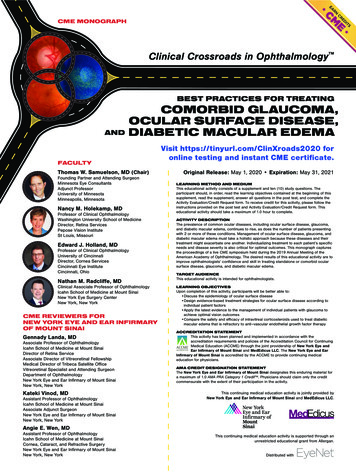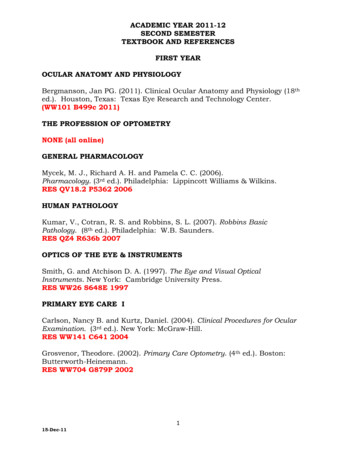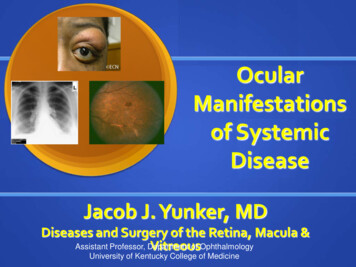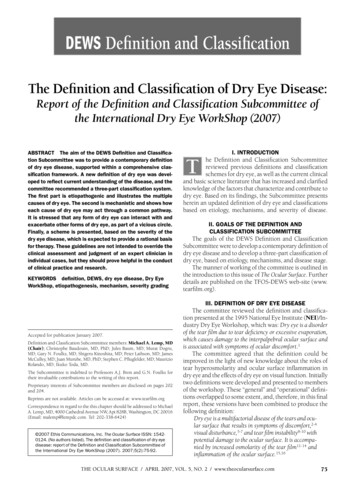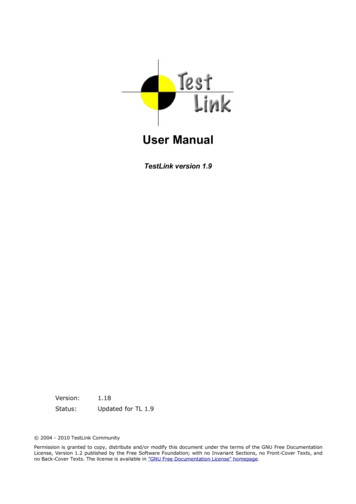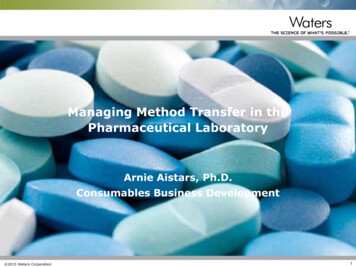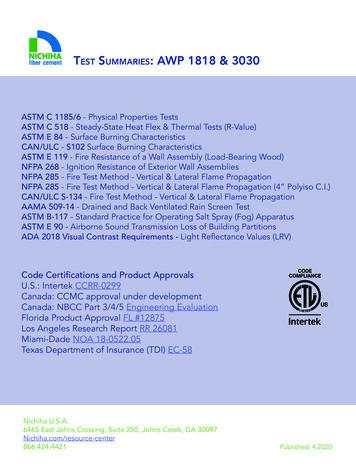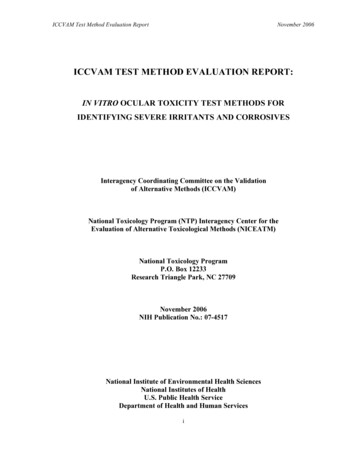
Transcription
ICCVAM Test Method Evaluation ReportNovember 2006ICCVAM TEST METHOD EVALUATION REPORT:IN VITRO OCULAR TOXICITY TEST METHODS FORIDENTIFYING SEVERE IRRITANTS AND CORROSIVESInteragency Coordinating Committee on the Validationof Alternative Methods (ICCVAM)National Toxicology Program (NTP) Interagency Center for theEvaluation of Alternative Toxicological Methods (NICEATM)National Toxicology ProgramP.O. Box 12233Research Triangle Park, NC 27709November 2006NIH Publication No.: 07-4517National Institute of Environmental Health SciencesNational Institutes of HealthU.S. Public Health ServiceDepartment of Health and Human Servicesi
ICCVAM Test Method Evaluation ReportNovember 2006This document is available electronically at:http://iccvam.niehs.nih.gov/methods/ocudocs/ocu brd.htm#ICCSevii
ICCVAM Test Method Evaluation Report: Table of ContentsNovember 2006TABLE OF CONTENTSLIST OF TABLES .viLIST OF ABBREVIATIONS AND ACRONYMS .viiINTERAGENCY COORDINGATING COMMITTEE ON THE VALIDATION OFALTERNATIVE METHODS –AGENCY REPRESENTATIVES .viiiACKNOWLEDGEMENTS .ixPREFACE .xiiiEXECUTIVE SUMMARY .xvii1.02.03.04.0INTRODUCTION .1THE BCOP TEST METHOD .52.1BCOP Technical Summary .52.1.1 Test Method Description .52.1.2 Validation Database.62.1.3 Test Method Accuracy.62.1.4 Test Method Reliability (Inter- and Intra-LaboratoryReproducibility).82.2ICCVAM Recommendations for the BCOP Test Method .92.2.1 Use of the BCOP Test Method.92.2.2 BCOP Test Method Protocol . 102.2.3 Optimization of the Current BCOP Test Method Protocol. 10THE ICE TEST METHOD. 133.1ICE Technical Summary . 133.1.1 Test Method Description . 133.1.2 Validation Database. 133.1.3 Test Method Accuracy. 143.1.4 Test Method Reliability (Inter- and Intra-LaboratoryReproducibility). 163.2ICCVAM Recommendations for the ICE Test Method. 163.2.1 Use of the ICE Test Method . 163.2.2 ICE Test Method Protocol . 173.2.3 Optimization of the Current ICE Test Method Protocol . 18THE IRE TEST METHOD. 194.1IRE Technical Summary . 194.1.1 Test Method Description . 194.1.2 Validation Database. 194.1.3 Test Method Accuracy. 204.1.4 Test Method Reliability (Inter- and Intra-LaboratoryReproducibility). 204.2ICCVAM Recommendations for the IRE Test Method. 224.2.1 Use of the IRE Test Method . 224.2.2 IRE Test Method Protocol . 234.2.3 Optimization of the Current IRE Test Method Protocol . 23iii
ICCVAM Test Method Evaluation Report: Table of Contents5.0November 2006THE HET-CAM TEST METHOD . 255.1HET-CAM Technical Summary. 255.1.1 Test Method Description . 255.1.2 Validation Database. 255.1.3 Test Method Accuracy. 265.1.4 Test Method Reliability (Inter- and Intra-LaboratoryReproducibility). 285.2ICCVAM Recommendations for the HET-CAM Test Method . 305.2.1 Use of the HET-CAM Test Method . 305.2.2 HET-CAM Test Method Protocol. 305.2.3 Optimization of the Current HET-CAM Test Method Protocol . 316.0COMPARISON OF PERFORMANCE CHARACTERISTICS ANDGENERAL RECOMMENDATIONS FOR FOUR EVALUATED INVITRO TEST METHODS . 337.0ICCVAM RECOMMENDATIONS ON SUBSTANCES FORVALIDATION OF IN VITRO OCULAR TOXICITY TEST METHODSFOR THE EVALUATION OF OCULAR CORROSIVES AND SEVEREIRRITANTS. 378.0REFERENCES . 39APPENDIX AEXPERT PANEL REPORTS .A-1A1Expert Panel Report: Evaluation of the Current Validation Status of InVitro Test Methods for Identifying Ocular Corrosives and SevereIrritants .A-3A2Expert Panel Report: Evaluation of the Current Validation Status of InVitro Test Methods for Identifying Ocular Corrosives and SevereIrritants – Addendum . A-135A3Summary Minutes from Expert Panel Meeting on January 11-12, 2005. A-153A4Summary Minutes from Expert Panel Teleconference on September19, 2005 . A-221APPENDIX BCOMPARISON OF PERFORMANCECHARACTERISTICS OF FOUR IN VITRO TESTMETHODS FOR THE IDENTIFICATION OF OCULARCORROSIVES OR SEVERE IRRITANTS . B-1B1Comparison of Performance Characteristics of Four In Vitro TestMethods for Identification of GHS Ocular Corrosives or SevereIrritants . B-3B2Comparison of Performance Characteristics of Four In Vitro TestMethods for Identification of EPA Ocular Corrosives or SevereIrritants . B-7B3Comparison of Performance Characteristics of Four In Vitro TestMethods for Identification of EU Ocular Corrosives or Severe Irritants. B-11APPENDIX CRELEVANT FEDERAL OCULAR IRRITATIONREGULATIONS AND TESTING GUIDELINES .C-1C1Table of Relevant Ocular Irritation Regulations. C-3C216CFR1500.42: Test for Eye Irritants. C-9C329CFR1910.1200: Hazard Communication . C-13iv
ICCVAM Test Method Evaluation Report: Table of ContentsNovember 2006C4Health Effects Test Guidelines OPPTS 870.2400: Acute Eye Irritation . C-39APPENDIX DICCVAM RECOMMENDED BCOP TEST METHODPROTOCOL.D-1APPENDIX EICCVAM RECOMMENDED ICE TEST METHODPROTOCOL. E-1APPENDIX FICCVAM RECOMMENDED IRE TEST METHODPROTOCOL. F-1APPENDIX GICCVAM RECOMMENDED HET-CAM TEST METHODPROTOCOL.G-1APPENDIX HICCVAM RECOMMENDED REFERENCESUBSTANCES LIST .H-1APPENDIX IFEDERAL REGISTER NOTICES AND PUBLICCOMMENTS . I-1I1Federal Register Notices. I-3I2ICCVAM Consideration of Public Comments Received in Response toFederal Register Notices. I-27v
ICCVAM Test Method Evaluation Report: List of TablesNovember 2006LIST OF TABLESTable 2-1Table 3-1Table 4-1Table 5-1Table 6-1False Positive and False Negative Rates of the BCOP Test Method, byChemical Class and Properties of Interest, for the GHS ClassificationSystem .7False Positive and False Negative Rates of the ICE Test Method, byChemical Class and Properties of Interest, for the GHS ClassificationSystem . 15False Positive and False Negative Rates of the IRE Test Method, byChemical Class and Properties of Interest, for the GHS ClassificationSystem (Analysis Based on the Pooled Data Set). 21False Positive and False Negative Rates of the HET-CAM TestMethod, by Chemical Class and Properties of Interest, for the GHSClassification System . 27Comparison of Performance Characteristics of Four In Vitro OcularTest Methods for the Identification of Severe Ocular Irritants orCorrosives, for Three Hazard Classification Systems. 34vi
ICCVAM Test Method Evaluation Report: List of Abbreviations and AcronymsNovember 2006LIST OF ABBREVIATIONS AND MICEIREISMeSHmLNICEATMNTPOTWGSACATMUNUV/VISDegrees CentigradeBovine Corneal Opacity and PermeabilityBackground Review DocumentChorioallantoic MembraneCoefficient of VariationEuropean Center for the Validation of Alternative MethodsU.S. Environmental Protection AgencyEuropean UnionFederal RegisterGramGlobally Harmonized SystemHen’s Egg Test-Chorioallantoic MembraneInteragency Coordinating Committee on the Validation of AlternativeMethodsIsolated Chicken EyeIsolated Rabbit EyeIrritation ScoreMedical Subject HeadingsMilliliterNational Toxicology Program Center for the Evaluation of AlternativeToxicological MethodsU.S. National Toxicology ProgramOcular Toxicity Working GroupScientific Advisory Committee on Alternative Toxicological MethodsUnited NationsUltraviolet/Visiblevii
ICCVAM Test Method Evaluation Report: ICCVAM RepresentativesNovember 2006INTERAGENCY COORDINATING COMMITTEE ON THE VALIDATIONOF ALTERNATIVE METHODS - AGENCY REPRESENTATIVESAgency for Toxic Substances and Disease Registry Moiz Mumtaz, Ph.D.Food and Drug Administration Leonard M. Schechtman, Ph.D. (Chair)Office of Science Suzanne Fitzpatrick, Ph.D., D.A.B.T.Center for Drug Evaluation and Research* Abigail C. Jacobs, Ph.D.Center for Devices and Radiological Health* Raju Kammula., D.V.M., Ph.D., D.A.B.T.* Melvin E. Stratmeyer, Ph.D.Center for Biologics Evaluation and Research* Richard McFarland, Ph.D., M.D.* Ying Huang, Ph.D.Center for Food Safety and Nutrition* David G. Hattan, Ph.D.* Robert L. Bronaugh, Ph.D.Center for Veterinary Medicine* Devaraya Jagannath, Ph.D.* M. Cecilia Aguila, D.V.M.National Center for Toxicological Research* William T. Allaben, Ph.D.Office of Regulatory Affairs* Lawrence A. D’Hoostelaere, Ph.D.Consumer Product Safety Commission Marilyn L. Wind, Ph.D. (Vice-Chair)* Kailash C. Gupta, D.V.M., Ph.D.* Patricia Bittner, M.S.* Kristina Hatlelid, Ph.D.Department of Agriculture Jodie Kulpa-Eddy, D.V.M. Elizabeth Goldentyer, D.V.M.Department of Defense Robert E. Foster, Ph.D. Patty Decot* Harry Salem, Ph.D.Department of Energy Michael Kuperberg, Ph.D. Marvin Stodolsky, Ph.D.Department of the Interior Barnett A. Rattner, Ph.D. Sarah Gerould, Ph.D.National Cancer Institute Alan Poland, M.D. T. Kevin Howcroft, Ph.D.Department of Transportation George Cushmac, Ph.D. Steve Hwang, Ph.D.National Institute of Environmental HealthSciences William S. Stokes, D.V.M., D.A.C.L.A.M. John R. Bucher, Ph.D., D.A.B.T.* Rajendra S. Chhabra, Ph.D., D.A.B.T* Jerrold J. Heindel, Ph.D.Environmental Protection AgencyOffice of Science Coordination and Policy Karen Hamernik, Ph.D.Office of Research and Development Julian Preston, Ph.D.* Suzanne McMaster, Ph.D.OECD Test Guidelines Program* Jerry Smrchek, Ph.D.Office of Pesticides Programs* Amy Rispin, Ph.D.* Deborah McCallNational Institute for Occupational Safety andHealth Paul Nicolaysen, V.M.D. K. Murali Rao, MD, Ph.D.National Institutes of Health Margaret D. Snyder, Ph.D.National Library of Medicine Vera Hudson, M.S. Jeanne Goshorn, M.S. Principal Agency Representative Alternate Principal Agency Representative* Other Designated Agency Representatives8-25-2006Occupational Safety and Health Administration Surender Ahir, Ph.D.viii
ICCVAM Test Method Evaluation Report: AcknowledgementsNovember 2006ACKNOWLEDGEMENTSThe following individuals are acknowledged for theircontributions to the in vitro ocular test method review processInteragency Coordinating Committee on the Validation of Alternative Methods(ICCVAM) Ocular Toxicity Working Group (OTWG)Consumer Product Safety CommissionKailash Gupta, Ph.D.Cassandra Prioleau, Ph.D.Marilyn Wind, Ph.D.(ICCVAM, Vice-Chair)Department of DefenseHarry Salem, Ph.D.Department of TransportationSteve Hwang, Ph.D.Environmental Protection AgencyKaren Hamernik, Ph.D. (OTWG, Co-Chair)Meta Bonner, Ph.D.Andrew Geller, Ph.D.Karen HicksMarianne LewisDeborah McCallMark Perry, Ph.D.John Redden, Ph.D.Amy Rispin, Ph.D.Food and Drug AdministrationJill Merrill, Ph.D. (OTWG, Co-Chair)Robert Bronaugh, Ph.D.Paul Brown, Ph.D.Wiley Chambers, M.D.Abigail Jacobs, Ph.D.Donnie LowtherLeonard Schechtman, Ph.D. (ICCVAM, Chair)Occupational Safety and HealthAdministrationSurender Ahir, Ph.D.National Institute of Environmental HealthSciencesRaymond Grissom, Ph.D.William Stokes, D.V.M., D.A.C.L.A.M.(Director, NICEATM)Raymond Tice, Ph.D.(Deputy Director, NICEATM)ECVAM LiaisonChantra Eskes, Eng., Ph.D.ix
ICCVAM Test Method Evaluation Report: AcknowledgementsNovember 2006In Vitro Ocular Test Methods Expert PanelRobert Scala, Ph.D. (Panel Chair), Consultant, Tucson, ArizonaSally Atherton, Ph.D., Professor, Medical College of Georgia, Augusta, GeorgiaRoger Beuerman, Ph.D., Professor, Louisiana State University, New Orleans, LouisianaJune Bradlaw, Ph.D., International Foundation for Ethical Research, Rockville, MarylandIh Chu, Ph.D., Health Canada, Ottawa, CanadaHenry Edelhauser, Ph.D., Professor, Emory University, Atlanta, GeorgiaNancy Flournoy, Ph.D., Professor, University of Missouri, Columbia, MissouriDonald Fox, Ph.D., Professor, University of Houston, Houston, TexasJames Freeman, Ph.D., Section Head, ExxonMobil Biomedical Sciences, Inc., Annandale,New JerseyShayne Gad, Ph.D., D.A.B.T., A.T.S., Consultant, Gad Consulting Services, Cary, NorthCarolinaSidney Green, Ph.D., A.T.S., Graduate Professor, Howard University, Washington, DCFrederick Guerriero, M.S., Senior Occupational Toxicologist, GlaxoSmithKline, King ofPrussia, PennsylvaniaA. Wallace Hayes, Ph.D., D.A.B.T., F.A.T.S., F.I.Biol., F.A.C.F.E., E.R.T., Scientist,Harvard School of Public Health, Andover, MassachusettsHiroshi Itagaki, Ph.D., Principal Scientist, Shiseido Co., Ltd., JapanDavid Lovell, Ph.D., Reader in Medical Statistics, University of Surrey, United KingdomYasuo Ohno, Ph.D., D.J.S.T.S., Director of Japanese Society of Alternatives to AnimalExperiments and Director of Division of Pharmacology, National Institute of HealthSciences, JapanRobert Peiffer, D.V.M., D.A.C.V.O., Senior Investigator, Merck Research Laboratories,West Point, PennsylvaniaLionel Rubin, V.M.D., D.A.C.V.O., Emeritus Professor of Ophthalmology, University ofPennsylvania, Philadelphia, PennsylvaniaHorst Spielmann, Dr. Med., Director and Professor, ZEBET at the BfR, Berlin, GermanyMartin Stephens, Ph.D., Vice President for Animal Research, Humane Society of theUnited States, Washington DCKatherine Stitzel, D.V.M., Consultant, West Chester, OhioPeter Theran, V.M.D., D.A.C.V.I.M., Vice President Animal Science, MassachusettsSociety for the Prevention of Cruelty to Animals, Novato, CaliforniaScheffer Tseng, M.D., Ph.D., Director, Ocular Surface Research and Education Foundation,Miami, FloridaPhilippe Vanparys, Ph.D., Senior Research Fellow, Johnson and Johnson, Belgiumx
ICCVAM Test Method Evaluation Report: AcknowledgementsNovember 2006National Toxicology Program Interagency Center for the Evaluationof Alternative Toxicological MethodsDavid Allen, Ph.D.ILS, Inc.Frank Deal, M.S.ILS, Inc.Bradley Blackard, M.S.P.H.ILS, Inc.Linda LitchfieldILS, Inc.Sue BrenzelILS, Inc.Deborah McCarleyNIEHSThomas Burns, M.S.ILS, Inc.Michael ParisILS, Inc.Patricia Ceger, M.S.ILS, Inc.William Stokes, D.V.M., D.A.C.L.A.M.(Director)NIEHSJeff Charles, Ph.D., M.B.A., D.A.B.T.ILS, Inc.Judy Strickland, Ph.D., D.A.B.T.ILS, Inc.Neepa Choksi, Ph.D.ILS, Inc.Raymond Tice, Ph.D. (Deputy Director)NIEHSJames Truax, M.A.ILS, Inc.xi
ICCVAM Test Method Evaluation Report: AcknowledgementsNovember 2006Additional ContributorsRobert L Guest Bsc, CBiol, MlBiolSafePharm Laboratories, Ltd.Derby, United KingdomMenk PrinsenTNO Nutrition & Food Research InstituteThe NetherlandsJohn Harbell, Ph.D.Institute for In Vitro SciencesGaithersburg, MarylandHorst Spielmann, Dr. Med.ZEBETBerlin, GermanyPenny JonesUnilever ResearchSharnbrook, United Kingdomxii
ICCVAM Test Method Evaluation Report: PrefaceNovember 2006PREFACEThe Interagency Coordinating Committee on the Validation of Alternative Methods(ICCVAM) is charged by the ICCVAM Authorization Act of 2000 (42 U.S.C. § 2851-2,2851-5 (2000); available at http://iccvam.niehs.nih.gov/about/PL106545.pdf) with evaluatingthe scientific validity of new, revised, and alternative toxicological test methods applicable toU.S. Federal agency safety testing requirements. Following such evaluations, ICCVAM isrequired to provide recommendations to U.S. Federal agencies regarding the usefulness andlimitations of such methods.In October 2003, the U.S. Environmental Protection Agency (EPA) formally nominatedseveral ocular toxicity test method activities to ICCVAM. ICCVAM determined that four invitro test methods proposed for identifying potential ocular corrosives and severe irritants ina tiered-testing strategy should have the highest priority for evaluation. This was based onthe availability of existing validation data for all four methods and the fact that determiningthe adequacy of validation1 is a prerequisite for test methods to be considered for regulatoryacceptance (ICCVAM 1997, 2003). The four test methods were the Bovine Corneal Opacityand Permeability (BCOP) assay, the Hen’s Egg Test - Chorioallantoic Membrane (HETCAM) assay, the Isolated Chicken Eye (ICE) assay, and the Isolated Rabbit Eye (IRE) assay.An ICCVAM Ocular Toxicity Working Group (OTWG) was established to work with theNational Toxicology Program (NTP) Interagency Center for the Evaluation of AlternativeToxicological Methods (NICEATM) to carry out the test method evaluations. ICCVAM andNICEATM also collaborated closely with the European Centre for the Validation ofAlternative Methods (ECVAM) in conducting the evaluations, with Dr. Chantra Eskesserving as ECVAM liaison to the OTWG.NICEATM, in conjunction with the OTWG, prepared four comprehensive backgroundreview documents (BRDs) reviewing the available data and information for each of the fourin vitro test methods. Each BRD described the current validation status of the in vitro testmethod, including its reliability and accuracy, the scope of the substances tested, and theavailability of a standardized protocol. The BRDs were based on published studies using therespective test method, and other data and information submitted in response to a 2004 publiccall for information. The draft BRDs were made available to the public for comment onNovember 1, 2004, and a public, independent expert panel meeting also was announced.ICCVAM organized an international, independent Expert Panel meeting on January 11-12,2005, to assess the validation status of these four in vitro test methods for identifying ocularcorrosives or severe irritants. While a comprehensive review was conducted, publiccomments at the meeting revealed that additional relevant data were available that had notyet been provided in response to earlier requests for data. Accordingly, the Expert Panelrecommended that if such data could be obtained, a reanalysis of each test method should be1Validation is the process by which the reliability and relevance of a test method are established for a specificpurpose (ICCVAM 1997, 2003).xiii
ICCVAM Test Method Evaluation Report: PrefaceNovember 2006performed. Availability of the Expert Panel’s independent report was announced on March21, 2005.In response to the Expert Panel’s recommendation, a second public request for in vitro datawas published on February 28, 2005. In response to this request, additional in vitro testmethod data and corresponding in vivo rabbit eye test results were submitted for the BCOP,HET-CAM, and ICE test methods. The additional data, together with clarified rules forhazard classification and reclassification of the chemical classes of the test substancesnecessitated a reanalysis of the accuracy and reliability of all four test methods. Theaccuracy and reliability reanalyses and a revised reference substances list for validation of invitro tests to detect ocular corrosives and severe irritants were provided in a BRD Addendumreleased on July 26, 2005.The Expert Panel was subsequently reconvened via teleconference on September 19, 2005 todiscuss the BRD Addendum. The Expert Panel provided final conclusions regarding theeffects of the information in the BRD Addendum on their original evaluation from theJanuary 11-12, 2005 meeting. The report of this meeting also was published and publiccomments requested.The draft BRDs, draft BRD Addendum, Expert Panel report and addendum, and all publiccomments were subsequently made available to the Scientific Advisory Committee onAlternative Toxicological Methods (SACATM) for comment at their meeting on December12, 2005. The SACATM concurred with the consensus conclusions of the Expert Panel.ICCVAM and OTWG considered the Expert Panel report and addendum, the revisedaccuracy and reliability analyses, all public comments, and the comments of SACATM inpreparing the final ICCVAM test method recommendations provided in this report. Thisreport will be made available to the public and provided to U.S. Federal agencies forconsideration, in accordance with the ICCVAM Authorization Act of 2000 (42 U.S.C.§ 2851-2, 2851-5 [2000]) (Available at encies with applicable testing regulations and/or guidelines must respond to ICCVAMwithin 180 days after receiving the ICCVAM recommendations. These responses will bemade available to the public on the ICCVAM website (http://iccvam.niehs.nih.gov) as theyare received.In this Test Method Evaluation Report, ICCVAM states that there are sufficient data tosubstantiate the use of the BCOP or the ICE test methods, with certain limitations, asscreening tests to identify substances as ocular corrosives and severe irritants in a tieredtesting strategy, using a weight-of-evidence approach, for regulatory hazard classificationpurposes. When used in this manner, these methods should reduce the number of animalsneeded for ocular toxicity testing and refine animal use by avoiding the pain and distressassociated with testing severely irritating and corrosive substances. Since ocular irritancytesting may involve more than slight or momentary pain or distress, available alternative testmethods must be considered prior to the use of animals, as required by U.S. Federal animalwelfare regulations and policies. Accordingly, in vitro alternative test methods should beconsidered prior to in vivo ocular testing and used where determined appropriate for axiv
ICCVAM Test Method Evaluation Report: PrefaceNovember 2006specific testing situation. Consistent with the mission of ICCVAM, appropriate use of thesemethods will support improved animal welfare while ensuring the continued protection ofhuman health.AcknowledgmentsThe efforts of many individuals who contributed to the preparation, review, and revision ofthis report are gratefully acknowledged. We especially recognize all of the Expert Panelmembers for their thoughtful evaluations and generous contributions of time and effort.Special thanks are extended to Dr. Robert Scala for serving as both the Panel Chair and aGroup Chair and to Drs. Kathy Stitzel, James Freeman, and Shayne Gad for their service asGroup Chairs. The efforts of the OTWG were invaluable for assuring a meaningful andcomprehensive review. We especially would like to thank the co-chairs of the OTWG, Drs.Jill Merrill (U.S. Food and Drug Administration) and Karen Hamernik (U.S. EnvironmentalProtection Agency) for their leadership. The efforts of the NICEATM staff in preparing theBRDs, organizing the Expert Panel meeting and teleconference, and preparing this finalreport are greatly appreciated. We also acknowledge Drs. David Allen, Jeff Charles, andNeepa Choksi and Messrs. Bradley Blackard, Thomas Burns, and James Truax of IntegratedLaboratory Systems (ILS), Inc., the NICEATM Support Contractor, and Dr. Raymond Ticefor his initial contributions as a member of the ILS, Inc. support contract and later as amember of NICEATM.William S. Stokes, D.V.M. D.A.C.L.A.M.Rear Admiral, U.S. Public Health ServiceDirector, NICEATMExecutive Director, ICCVAMLeonard Schechtman, Ph.D.Deputy Director, FDA, National Center forToxicological Research, Washington OperationsChair, ICCVAMxv
ICCVAM Test Method Evaluation Report: PrefaceNovember 2006[This Page Intentionally Left Blank]xvi
ICCVAM Test Method Evaluation Report: Executive SummaryNovember 2006EXECUTIVE SUMMARYThe Interagency Coordinating Committee on the Validation of Alternative Methods(ICCVAM) recently completed the technical evaluation of the validation status of four invitro ocular irritation test methods proposed as screening tests2 for identifying potentialocular corrosives and severe irritants in a tiered-testing strategy3, as part of a weight-ofevidence approach. The four test methods are the Bovine Corneal Opacity and Permeability(BCOP) assay, the Hen’s Egg Test - Chorioallantoic Membrane (HET-CAM) assay, theIsolated Chicken Eye (ICE) assay, and the Isolated Rabbit Eye (IRE) assay. The U.S.Environmental Protection Agency (EPA) formally nominated these test methods forevaluation by ICCVAM in October 2003. In addition to evaluating their current usefulnessand limitations as screening tests for identifying ocular corrosives and severe irritants,ICCVAM developed a recommended standardized protocol for each test method; maderecommendations, where considered appropriate, for further research and development,optimization, and/or validation efforts; and developed a list of reference substances for suchactivities.None of the four in vitro test methods evaluated can be considered to be replacements for thein vivo rabbit eye test. However, based on the available data, BCOP and ICE can be used, inappropriate circumstances and with certain limitations, as screening tests for the detection ofocular corrosives and severe irritants in a tiered-testing strategy, as part of a weight-ofevidence approach. At the present time, HET-CAM, using the decision criteria of Luepke(1985), and IRE are not recommended as screening tests for the identification of ocularcorrosives and severe irritants for regulatory hazard classification purposes. Before HETCAM and IRE can be recommended for this purpose, the protocol and the decision criteriafor the identification of ocular corrosives and severe irritants need to be optimized andundergo further validation.This evaluation provides validation information that should be helpful to variousstakeholders (e.g., applicable U.S. Federal regulatory agencies; the international regulatorycommunity; the pharmaceutical, pesticide, and commercial chemical industries) indetermining when these test methods might be useful and which test method might be themost appropriate for a specific testing situation. These in vitro test methods, when usedappropriately, will reduce an
ICCVAM Test Method Evaluation Report: List of Abbreviations and Acronyms November 2006 . LIST OF ABBREVIATIONS AND ACRONYMS . o. C Degrees Centigrade BCOP Bovine Corneal Opacity and Permeability BRD Background Review Document CAM Chorioallantoic Membrane CV Coefficient of Variation ECVAM European Center for the Validation of Alternative Methods
